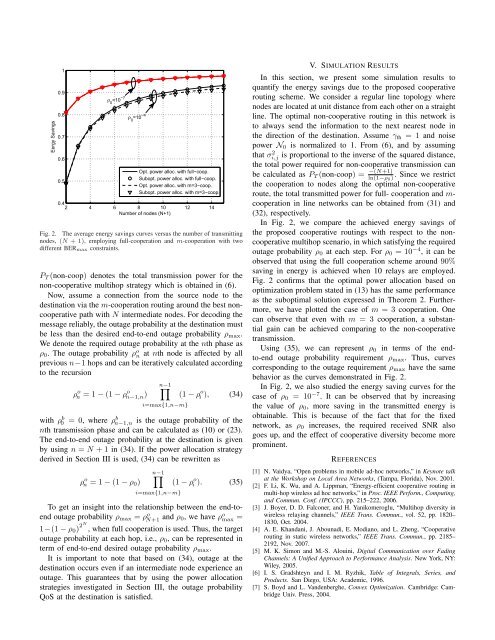Minimum Power Allocation for Cooperative Routing in ... - Unik
Minimum Power Allocation for Cooperative Routing in ... - Unik
Minimum Power Allocation for Cooperative Routing in ... - Unik
You also want an ePaper? Increase the reach of your titles
YUMPU automatically turns print PDFs into web optimized ePapers that Google loves.
Eergy Sav<strong>in</strong>gs10.90.80.70.60.5ρ 0=10 −7ρ 0=10 −4Opt. power alloc. with full−coop.Subopt. power alloc. with full−coop.Opt. power alloc. with m=3−coop.Subopt. power alloc. with m=3−coop.0.42 4 6 8 10 12 14Number of nodes (N+1)Fig. 2. The average energy sav<strong>in</strong>gs curves versus the number of transmitt<strong>in</strong>gnodes, (N + 1), employ<strong>in</strong>g full-cooperation and m-cooperation with twodifferent BER max constra<strong>in</strong>ts.P T (non-coop) denotes the total transmission power <strong>for</strong> thenon-cooperative multihop strategy which is obta<strong>in</strong>ed <strong>in</strong> (6).Now, assume a connection from the source node to thedest<strong>in</strong>ation via the m-cooperation rout<strong>in</strong>g around the best noncooperativepath with N <strong>in</strong>termediate nodes. For decod<strong>in</strong>g themessage reliably, the outage probability at the dest<strong>in</strong>ation mustbe less than the desired end-to-end outage probability ρ max .We denote the required outage probability at the nth phase asρ 0 . The outage probability ρ o n at nth node is affected by allprevious n−1 hops and can be iteratively calculated accord<strong>in</strong>gto the recursionρ o n = 1 − (1 − ρ o n−1,n)n−1∏i=max{1,n−m}(1 − ρ o i ), (34)with ρ0b = 0, where ρn−1,n b is the outage probability of thenth transmission phase and can be calculated as (10) or (23).The end-to-end outage probability at the dest<strong>in</strong>ation is givenby us<strong>in</strong>g n = N + 1 <strong>in</strong> (34). If the power allocation strategyderived <strong>in</strong> Section III is used, (34) can be rewritten asρ o n = 1 − (1 − ρ 0 )n−1∏i=max{1,n−m}(1 − ρ o i ). (35)To get an <strong>in</strong>sight <strong>in</strong>to the relationship between the end-toendoutage probability ρ max = ρ o N+1 and ρ 0, we have ρ o max =1−(1 − ρ 0 ) 2N , when full cooperation is used. Thus, the targetoutage probability at each hop, i.e., ρ 0 , can be represented <strong>in</strong>term of end-to-end desired outage probability ρ max .It is important to note that based on (34), outage at thedest<strong>in</strong>ation occurs even if an <strong>in</strong>termediate node experience anoutage. This guarantees that by us<strong>in</strong>g the power allocationstrategies <strong>in</strong>vestigated <strong>in</strong> Section III, the outage probabilityQoS at the dest<strong>in</strong>ation is satisfied.V. SIMULATION RESULTSIn this section, we present some simulation results toquantify the energy sav<strong>in</strong>gs due to the proposed cooperativerout<strong>in</strong>g scheme. We consider a regular l<strong>in</strong>e topology wherenodes are located at unit distance from each other on a straightl<strong>in</strong>e. The optimal non-cooperative rout<strong>in</strong>g <strong>in</strong> this network isto always send the <strong>in</strong><strong>for</strong>mation to the next nearest node <strong>in</strong>the direction of the dest<strong>in</strong>ation. Assume γ th = 1 and noisepower N 0 is normalized to 1. From (6), and by assum<strong>in</strong>gthat σi,j 2 is proportional to the <strong>in</strong>verse of the squared distance,the total power required <strong>for</strong> non-cooperative transmission canbe calculated as P T (non-coop) = −(N+1)ln(1−ρ 0 ). S<strong>in</strong>ce we restrictthe cooperation to nodes along the optimal non-cooperativeroute, the total transmitted power <strong>for</strong> full- cooperation and m-cooperation <strong>in</strong> l<strong>in</strong>e networks can be obta<strong>in</strong>ed from (31) and(32), respectively.In Fig. 2, we compare the achieved energy sav<strong>in</strong>gs ofthe proposed cooperative rout<strong>in</strong>gs with respect to the noncooperativemultihop scenario, <strong>in</strong> which satisfy<strong>in</strong>g the requiredoutage probability ρ 0 at each step. For ρ 0 = 10 −4 , it can beobserved that us<strong>in</strong>g the full cooperation scheme around 90%sav<strong>in</strong>g <strong>in</strong> energy is achieved when 10 relays are employed.Fig. 2 confirms that the optimal power allocation based onoptimization problem stated <strong>in</strong> (13) has the same per<strong>for</strong>manceas the suboptimal solution expressed <strong>in</strong> Theorem 2. Furthermore,we have plotted the case of m = 3 cooperation. Onecan observe that even with m = 3 cooperation, a substantialga<strong>in</strong> can be achieved compar<strong>in</strong>g to the non-cooperativetransmission.Us<strong>in</strong>g (35), we can represent ρ 0 <strong>in</strong> terms of the endto-endoutage probability requirement ρ max . Thus, curvescorrespond<strong>in</strong>g to the outage requirement ρ max have the samebehavior as the curves demonstrated <strong>in</strong> Fig. 2.In Fig. 2, we also studied the energy sav<strong>in</strong>g curves <strong>for</strong> thecase of ρ 0 = 10 −7 . It can be observed that by <strong>in</strong>creas<strong>in</strong>gthe value of ρ 0 , more sav<strong>in</strong>g <strong>in</strong> the transmitted energy isobta<strong>in</strong>able. This is because of the fact that <strong>for</strong> the fixednetwork, as ρ 0 <strong>in</strong>creases, the required received SNR alsogoes up, and the effect of cooperative diversity become moreprom<strong>in</strong>ent.REFERENCES[1] N. Vaidya, “Open problems <strong>in</strong> mobile ad-hoc networks,” <strong>in</strong> Keynote talkat the Workshop on Local Area Networks, (Tampa, Florida), Nov. 2001.[2] F. Li, K. Wu, and A. Lippman, “Energy-efficient cooperative rout<strong>in</strong>g <strong>in</strong>multi-hop wireless ad hoc networks,” <strong>in</strong> Proc. IEEE Per<strong>for</strong>m., Comput<strong>in</strong>g,and Commun. Conf. (IPCCC), pp. 215–222, 2006.[3] J. Boyer, D. D. Falconer, and H. Yanikomeroglu, “Multihop diversity <strong>in</strong>wireless relay<strong>in</strong>g channels,” IEEE Trans. Commun., vol. 52, pp. 1820–1830, Oct. 2004.[4] A. E. Khandani, J. Abounadi, E. Modiano, and L. Zheng, “<strong>Cooperative</strong>rout<strong>in</strong>g <strong>in</strong> static wireless networks,” IEEE Trans. Commun., pp. 2185–2192, Nov. 2007.[5] M. K. Simon and M.-S. Alou<strong>in</strong>i, Digital Communication over Fad<strong>in</strong>gChannels: A Unified Approach to Per<strong>for</strong>mance Analysis. New York, NY:Wiley, 2005.[6] I. S. Gradshteyn and I. M. Ryzhik, Table of Integrals, Series, andProducts. San Diego, USA: Academic, 1996.[7] S. Boyd and L. Vandenberghe, Convex Optimization. Cambridge: CambridgeUniv. Press, 2004.
















